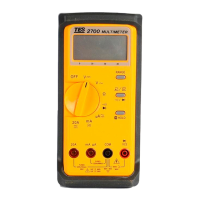
Do you have a question about the TES TES-2700 and is the answer not in the manual?
| Brand | TES |
|---|---|
| Model | TES-2700 |
| Category | Multimeter |
| Language | English |
Read and follow safety information before operating or servicing the meter to avoid damage and ensure safe use.
Caution regarding shock hazard when working with voltages above 60V DC or 30 V AC RMS.
Explains symbols for caution, dangerous voltages, insulation, and replacement parts for user safety.
Details environment conditions, operation ambient, and maintenance/cleaning procedures for the multimeter.
Defines display symbols and explains range selection, over-range, and low battery indications.
Covers specifications for DC/AC Voltage, DC/AC Current, Resistance, Diode Test, and Continuity measurements.
Provides detailed electrical parameters including accuracy, impedance, and overload protection for various measurements.
Details battery life, polarity, operating/storage conditions, dimensions, weight, and accessories.
Identifies and locates various parts and controls on the multimeter using a diagram.
Explains the purpose of measuring connectors and the function of buttons like RANGE, HOLD, and AC/DC select.
Describes the LCD display elements including measured values, units, and indicators like polarity, range, and battery status.
Step-by-step instructions for performing DC and AC voltage measurements with the multimeter.
Step-by-step instructions for performing DC and AC current measurements, including series connection.
Procedure for testing diodes, including connection, range selection, and interpretation of forward voltage.
Guide to measuring resistance, including connection, range selection, and safety precautions before measurement.
Instructions for performing continuity tests, including connection and beep indication for low impedance circuits.
Instructions for checking battery status and replacing the two AAA 1.5V batteries when indicated.
Procedure for replacing the fuse with a 0.5A/250A or 20A/600V fast blow type.
